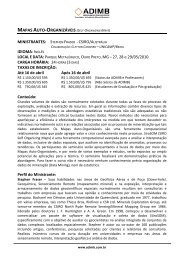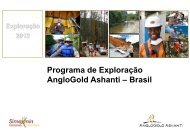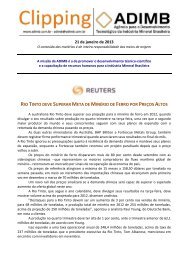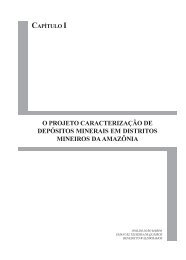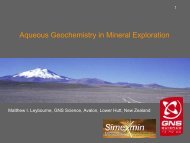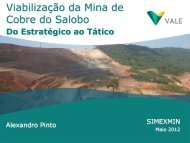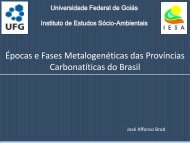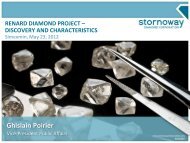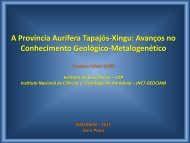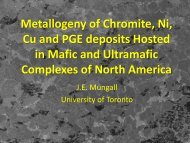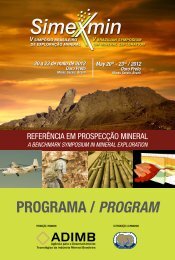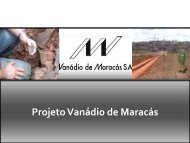Orogenic Gold Fluids - ADIMB
Orogenic Gold Fluids - ADIMB
Orogenic Gold Fluids - ADIMB
You also want an ePaper? Increase the reach of your titles
YUMPU automatically turns print PDFs into web optimized ePapers that Google loves.
Características e Critérios da Exploração de Depósitos<br />
Orogenéticos de Ouro<br />
Richard <strong>Gold</strong>farb, goldfarb@usgs.gov, SIMEXMIN 2012
Archean Lode <strong>Gold</strong> Deposits<br />
• Greenstone Belts in granitoid-greenstone terranes<br />
• Yilgarn, Zimbabwe, South Africa, Tanzanioa, central<br />
Brazil, Kolar, Superior<br />
• Tholeiitic basalt, dolerite, ultramafics, granitoid, but<br />
also BIFs and carbonaceous seds in greenstones
Phanerozoic Lode <strong>Gold</strong> Deposits<br />
• Accreted oceanic sequences; Continental margins<br />
• Metasedimentary host rock terranes<br />
• Mother Lode, Russian Far East, Tasman, Otago,<br />
Central Asia, Eastern Cordillera (S.A.), Alaska, BC
Mid 1980s—Recognized as a Single<br />
Deposit Type<br />
• Low- Sulfide<br />
• Mesothermal<br />
• Mother Lode<br />
• Metamorphic<br />
• <strong>Orogenic</strong>
Spatial/Temporal(±)<br />
Association with<br />
Granitoids, but NOT<br />
Genetic
Spatial/Temporal Association with VMS’
KEY REGIONAL<br />
EXPLORATION TARGETS<br />
1) Major structure<br />
2) Metamorphic grade<br />
3) Physical or chemical trap
Crustal-scale Deformation (Shear) Zones
<strong>Gold</strong>en Mile (1,200 t)<br />
<strong>Gold</strong> Deposit=Focused flow<br />
of large fluid volume; controlled<br />
by rock permeability and thus<br />
crustal deformation
Spatial Association with Deep Crustal<br />
Faults/Terrane Boundaries (Juneau)
FOCUS OF ORE FLUIDS: VARIATIONS IN<br />
STRIKE OF CRUSTAL-SCALE FAULTS
GOLD-GREENSCHIST ASSOCIATION
<strong>Orogenic</strong> <strong>Gold</strong> Tonnages: Archean MM Settings<br />
(from R. Kerrich, 2009)
• Ore Deposition POSTDATES Metamorphism of Host Rocks<br />
• Late-kinematic Timing
CRITICAL STRUCTURAL<br />
CONTROLS<br />
• Late structural timing of gold is important<br />
constraint.<br />
• Geometry visible today is close to<br />
geometry during mineralization.<br />
• For selective failure of specific rock units<br />
need:<br />
a) Large strength contrasts between<br />
units.<br />
b) Complex geometry<br />
c) Isolation of competent units in<br />
incompetent units.
Chemical Trap=Homestake Fm BIF
Chemical vs. Physical Traps for <strong>Orogenic</strong> Au<br />
from D. Groves
Deformation Styles
<strong>Gold</strong> Occurrences
Alaska-Juneau Deposit Paragenesis--Mafic Host Rock
Mineralogy of Giants
Sericitic Alteration
Listwanite
Carbonization of Wallrocks
Subika Alteration, South Ahafo district, Ghana<br />
from Enders et al., 2008
Liswanites in Pz metased terranes, Xinjiang
from Hodgson, <strong>Gold</strong> 2000<br />
SULFIDATION<br />
Hodgson, <strong>Gold</strong> 2000
Arsenopyrite and/or pyrite haloes
Whole rock data:<br />
Geochemistry of Alteration<br />
CO 2, K 2O, H 2O, S, Au, As (± Ag, Bi, Sb, Mo)<br />
SiO 2, Na 2O, (± MgO, P 2O 5, Sr)<br />
REE, HFSE<br />
Bulk chemical changes at constant mass (lithological variations)<br />
Alteration Index (CO 2 + K 2O)/(CO 2 + K 2O + Na 2O + Al 2O 3)<br />
Bierlein & Crowe, 2000
<strong>Gold</strong>: The Best Pathfinder?
from Groves, Ore Deposit Models
Colvine’s<br />
observations that<br />
there is a P-T control<br />
on ore style in the<br />
Superior province
HIGH TEMPERATURE OROGENIC GOLD<br />
Yilgarn (Southern Cross) Muruntau stockworks
Fluid Inclusions<br />
• Ore Fluid Chemistry<br />
• P-T of Ore Deposition<br />
• Ore fluid Source?
Best Inclusions - Sulfide Pressure Shadows
Generally 5-20 mole % gas
CO 2-rich <strong>Fluids</strong><br />
orogenic<br />
IRGD<br />
Ridley, <strong>Gold</strong> 2000
Laser Analysis of Volatiles
<strong>Orogenic</strong> <strong>Gold</strong> <strong>Fluids</strong><br />
• Temperatures ~ 250-400 o C<br />
• Pressure >1-4 kb<br />
• Fluid comp H 2O-CO 2 + CH 4, N 2, H 2S<br />
• Salinity
POSSIBLE FLUID SOURCE REGIONS<br />
• ISOTOPIC STUDIES?<br />
from Ridley and Diamond, <strong>Gold</strong> 2000
d 34 S of Alaskan <strong>Orogenic</strong> Deposits
Large et al, 2010
Isotopically Heavy <strong>Fluids</strong>--<strong>Orogenic</strong> Au
Fluid Inclusion Waters--<br />
Meaningful dD?
Mm Belts: Metals versus Grades<br />
• P-P: 3-22 ppm As, 160-910<br />
ppb Sb, 12-123 ppb Hg<br />
• Sillimanite: 0.3-0.9 ppm<br />
As, 20-40 ppb Sb,
Metal Depletions in Otago<br />
Schist, NZ<br />
• Depletion of metals in schist<br />
relative to mm temps.<br />
from Pitcairn, 2006<br />
• Concentration of metals in<br />
deposits at higher crustal levels
SUPPORT FOR METAMORPHIC<br />
MODEL<br />
• No <strong>Gold</strong> in High Grade MM Rocks<br />
• Gas Chemistry of Ore <strong>Fluids</strong><br />
• dD and d 18 O of Ore <strong>Fluids</strong><br />
• Uniform d 18 O Values for Veins<br />
• Change in As, Au, Bi, Hg and Sb with MM<br />
grade
GREENSCHIST-AMPHIBOLITE P-T
Phanerozoic <strong>Orogenic</strong> <strong>Gold</strong> Provinces
Precambrian <strong>Orogenic</strong> <strong>Gold</strong><br />
Boring<br />
Billion



